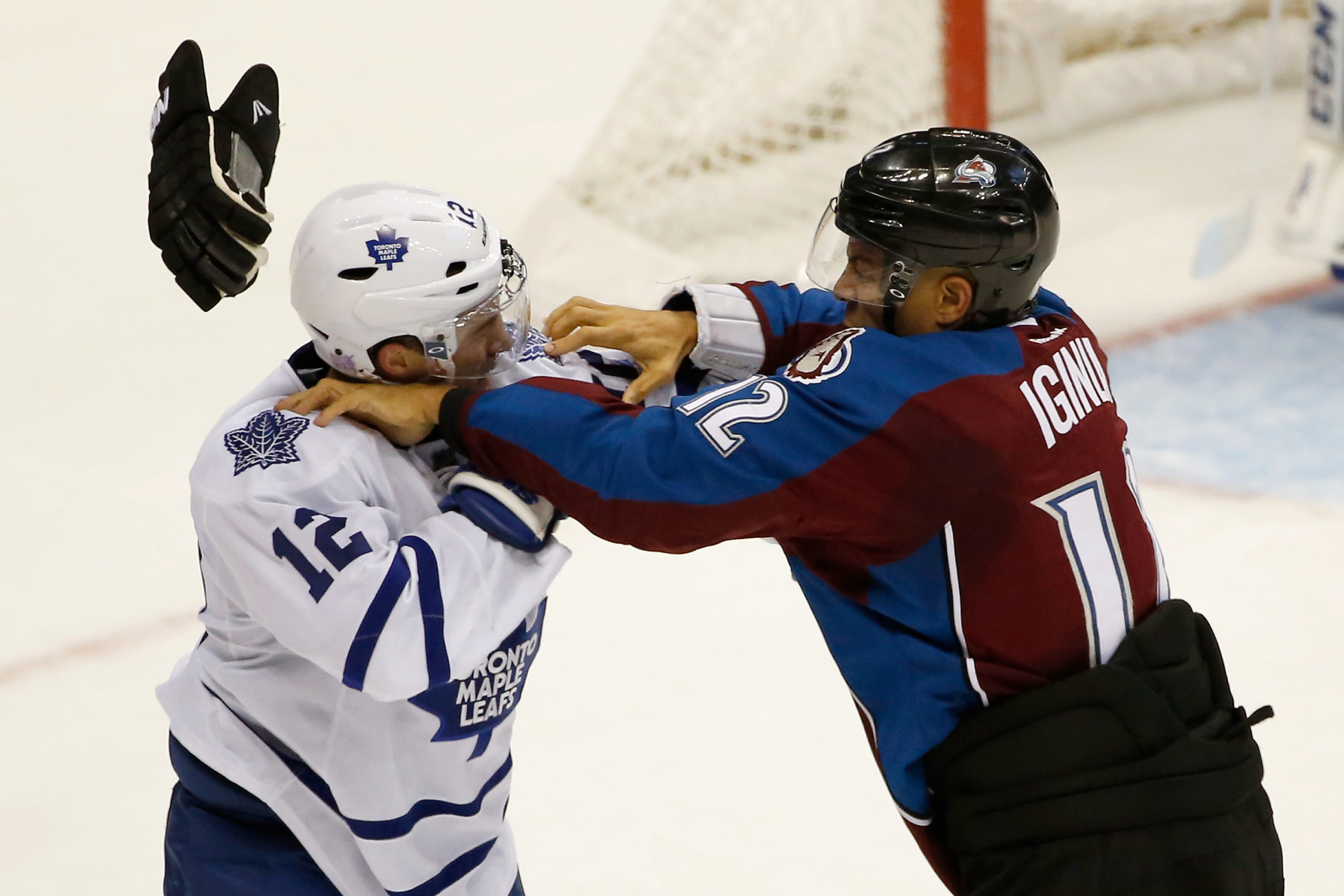On 91.9 Sport in Montreal this morning, injured Maple Leafs defenceman Stephane Robidas discussed his status entering the new season.
The key quotes can be found on 91.9’s Twitter feed. Here are those tweets translated into English:
“There is no improvement on the side of my leg, it’s impossible for me to play.”
“I’m 39 years old, it’s the last year of my contract… I haven’t played in two years.”
“Without ever mentioning retirement, Stéphane Robidas tells us: ‘I don’t see how I could return to the game.’”
In his radio appearance, Robidas described an inability to run or skate due to an injury to his leg. Essentially, he is waiting until the end of the 2016-17 season – the end of his three-year contract with the Leafs — to make his retirement official. Nothing too shocking.
It’s obviously in Robidas’ best interest to collect this season’s $3M salary before retiring, and the Leafs would not benefit from Robidas retiring due to the fact that he signed an over-35 contract in 2014 and the cap hit is stuck with the team no matter what.
The fact that Robidas lost his entire 2015-16 to injury also does not make him eligible Season Opening Injury Reserve (SOIR) – which wipes the cap hit – due to the fact that Robidas is on a one-way contract (in simple terms, SOIR is designed for situations where a non-NHL regular ends up stuck on the NHL roster due to an injury in training camp).
We’ve all heard the funny ‘Loophole Lou’ and ‘Robidas Island’ jokes. The reality of the situation is that Long Term Injury Reserve (LTIR) does not provide free cap relief, the Leafs should avoid the relief if at all possible due to the guarantee of performance bonuses this season, and the Leafs have other options if they’re going to use LTIR cap relief this season (Nathan Horton, potentially Jared Cowen). It was never confirmed the Leafs actually placed Robidas on LTIR last season, nor did they have to in order to become cap compliant.
We have Robidas set as “IR” because we never confirmed he was placed on LTIR. Also, the Leafs had enough LTIR relief from placing Horton on LTIR that it would never have been necessary based on their roster.
– Cap Friendly via email
On the many moving pieces in the Leafs’ cap situation
With the news that the Leafs are getting dinged for a $512,000 bonus overage earlier this week due to the combination of performance bonuses and LTIR relief on Horton’s contract last season, they are now around $827,000 over the cap with a 25-man roster that includes all of Joffrey Lupul, Stephane Robidas, Jared Cowen and Nathan Horton. At least three of those players are not going to play for the Leafs this season and will be placed on injured reserve after training camp.
Cowen’s status on the team is pending a buyout grievance arbitration scheduled for early October. What hangs in the balance for the Leafs is the cushion needed to afford the performance bonus money that will be applied to their cap at the end of the 2016-17 season. A favourable ruling would wipe out Cowen’s $3.1 million cap number and replace it with a $650,000 cap credit. An unfavourable ruling will — barring other moves — likely necessitate the use of some LTIR relief and ensures all performance bonuses achieved will be penalized as an overage on their 2017-18 cap.
TML's Potential 2016-17 Performance Bonuses
| Player | Potential Performance Bonuses |
|---|---|
| Nikita Zaitsev | $850,000 |
| Mitch Marner | $850,000 |
| William Nylander | $850,000 |
| Auston Matthews | $2,850,000 |
| Connor Brown | $182,500 |
| Nikita Soshnikov | $182,500 |
| Kerby Rychel | $350,000 |
| Total | $6,115,000 |
The Leafs were not likely to have all seven of these players on their opening night roster in the first place, but due to the bonus cushion (7.5% of the salary cap, or $5.475 million on the current $73 million ceiling), cap reasons will ensure a few of them are not. Bonus cushion rules dictate that, in cases where potential performance bonuses combined (whether they’re achieved or not) exceed 7.5% of the cap, the excess is applied to the current season’s cap, not the following season’s. If all seven of these players were on the big club roster to start the season, the Leafs would incur a $640,000 cap hit in 2016-17 for exceeding the bonus cushion in addition to potential overages applied to next season’s cap. This is worth keeping in mind while contemplating roster battles and potential opening night lineups. It might give a player such as Zach Hyman (zero performance bonuses) a leg up on someone like Kerby Rychel ($350,000 in performance bonuses).
The good news is that the Leafs have only $49 million in cap dollars committed to 15 players next season with none of their current core players due up for contracts. That means any bonus overages would likely not be the end of the world in 2017-18. They will have to fill out their roster, however, and we can’t know what trades or free agent signings they may make between now and the start of the 2017-18 season. At the very least, somewhere around $5 million — Kessel’s $1.2 million in retained salary, Tim Gleason’s $1.33 million left over from the buyout, feasibly $2.5-3 million in bonuses — in dead cap space would fall under the category of “less than ideal.”
It’s also going to be an ongoing consideration for Leafs cap manager Brandon Pridham in the years to come as long as Nathan Horton is on their books and Auston Matthews — along with any other entry-level contract players with performance bonus money — is playing out his performance bonus-laden ELC.































